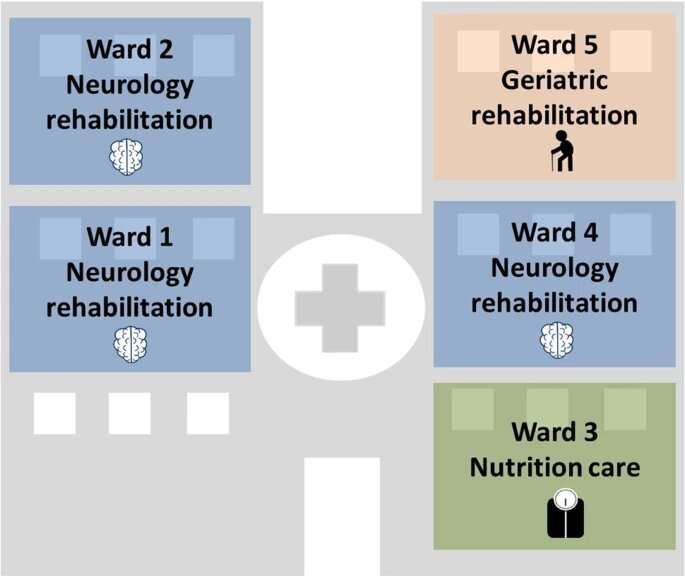This article has been reviewed according to Science X's editorial process and policies. Editors have highlighted the following attributes while ensuring the content's credibility:
fact-checked
peer-reviewed publication
proofread
Targeting nurse and patient 'supercontactors' in health care facilities can help minimize spread of infectious diseases

New research presented at this week's European Congress of Clinical Microbiology & Infectious Diseases (Copenhagen, April 15-18) shows how interventions focused on so-called "supercontactors" in hospitals and other long term care facilities (LTCF) can optimize infection control and reduce the spread of infectious diseases. The study is by Dr. Quentin Leclerc and colleagues at Institut Pasteur and the Conservatoire National des Arts et Métiers (Paris, France). It has been published in the journal Scientific Reports.
Hospitals and LTCF are hotspots for pathogen transmission. The frequency and nature of contacts between patients and staff have been shown to play an important role in the transmission of pathogens such as methicillin-resistant Staphylococcus aureus (MRSA). In this study, the authors combined mathematical modeling and detailed data on close-proximity interactions (CPI) in health care settings to investigate to which extent knowledge of the contact network can help implement effective interventions reducing the incidence of MRSA colonization.
The model was constructed using data collected over 3 months in a French LTCF at Berck-sur-Mer on the northern coast of France—a long-term rehabilitation hospital (average patient stay 3 months) composed of 151 patients and 236 staff, who were all followed up for methicillin-resistant Staphylococcus aureus (MRSA) colonization and tracked for CPIs using sensors (over 2.5 million CPIs recorded). On average, 5% of patients and staff were newly colonized with MRSA each week across the 3-month study.
Being colonized with MRSA means a person carries the bacteria in heir nose or skin, but they are not sick with a MRSA infection. But colonization is important because individuals are most likely to be infected (and made ill) by the S aureus that colonizes their systems. So, individuals colonized by MRSA are more likely to then be infected by that MRSA, which is then hard to treat with antibiotics. Dr. Leclerc explains, "By preventing colonization, we reduce the risk of infection. Basically, it is best to prevent the fire from even starting in the first place, instead of having to stop it later."
Using an extensive simulation study, the authors examined the potential impact on MRSA colonization incidence of three interventions:
- Firstly, staff reallocation, defined as the random attribution of a reduced number of patients to each staff member while maintaining global care needs, thereby reducing the number of unique contacts per staff.
- Secondly, reinforced contact precautions, which could include improved hand hygiene compliance or glove-wearing, thereby reducing patient-to-staff and staff-to-patient transmission.
- Thirdly, vaccination partially protecting those vaccinated against transmission from any other individual.
The authors say, "We considered that interventions cannot be feasibly applied to the whole population, and thus we need to investigate who should be targeted as a priority."
Simulation results showed that the intervention effect can be optimized by targeting "supercontactor" individuals. This includes both frequency-based supercontactors (with highest number of unique contacts), or duration-based supercontactors (with longest cumulative time spent in contact). In this study, supercontactors mostly included nurses; and patients with neurological disorders, typically those with conditions such as Alzheimer's disease and Parkinson's disease in neurological support wards, who—while less mobile than other patients—require more care (and thus more nurse/staff contacts).
The authors found that while full staff reallocation can reduce colonization incidence by up to 40%, reallocating only the 180 nurses (who are part of the 236 staff) is sufficient to obtain a 30% reduction. Interestingly, reinforced contact precautions targeting only the 180 nurses was shown by the model to be more effective than even reallocation of all staff, reducing colonization incidence by up to 45%.
For an equal number of individuals targeted, reinforced contact precautions and vaccination can be further optimized by targeting supercontactors instead of randomly selecting nurses. In an example targeting a fixed number of 60 individuals, the authors find that the highest reduction was achieved by targeting either duration-based patient supercontactors, or frequency-based staff supercontactors. Overall, the most efficient strategy in this example was to vaccinate duration-based patient supercontactors (the patients with neurological conditions described above), which the modeling showed would reduce colonization incidence by 23%.
The authors conclude, "Our analysis demonstrates the value of combining data collection in health care settings and modeling to inform intervention implementation. Identifying and targeting supercontactors was found to be key to implement optimized interventions against the transmission of infectious diseases in long-term care facilities. Because both staff and patients can be supercontactors, including patients in prevention interventions may be key in some health care institutions."
Dr. Leclerc adds, "While this study focused on MRSA, staff-patient contact networks in hospitals and other long-term care facilities also play a key role in the transmission of other diseases such as COVID-19 and influenza. Therefore, identifying supercontactors in different health care settings would substantially improve interventions to stop the spread of infectious diseases. To clarify this, we plan to repeat this work with other pathogens, in different health care institutions."





















